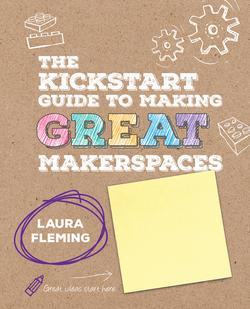Читать книгу The Kickstart Guide to Making GREAT Makerspaces - Laura Fleming - Страница 13
3 Empowering
ОглавлениеThe setup of your physical makerspace, along with the items in it, should invite all students in.
Makerspaces have the potential to empower students in endless ways. GREAT makerspaces ensure that everything created is celebrated by showcasing student creations both within the school community and with an authentic audience. In my makerspace, I take photos of all student creations and hang them up in a gallery that not only celebrates what our students have done but also serves as inspiration for their peers to make and create, too. In addition, I share their creations on Instagram and Twitter, using the hashtag of our makerspace, #worldsofmaking.
Jennie Martin, K–5 STEAM teacher for the Keystone Oaks School District, showcases group projects that students have done in her makerspace, since those are hard to split up and take home. She also uses her space to showcase the work of students who are easily frustrated and need some encouragement.
GREAT makerspaces can be deeply empowering to students on a very personal level. Take, for example, Michael, who started high school with no friends and as a result was oftentimes dejected and despondent. Michael began coming to our makerspace and became our computer science star. He decided to use his skills to create an arcade system. Yes, he created this arcade system because he had a passion for computer coding, but his real reason for creating the system was to use the skills he knew he was strong in to create something other kids would enjoy playing, which would hopefully make them want to be his friend. This is, in fact, what occurred. Now Michael continues to visit our makerspace and has a network of peers who accept and appreciate him.
Photo courtesy of Jennifer Martin
GREAT makerspaces give students a choice and allow them to take control of their own learning. They also help students feel more socially included by fostering peer-to-peer relationships and building creative confidence. Makerspaces offering open access to materials, supplies, and easy-to-start activities will guarantee successful and independent learners while limiting frustration.
The setup of your physical makerspace can play a significant role in empowering students. The use of visual cues can communicate and give necessary directions. This strategy can be especially beneficial for learners who have difficulty following complicated directions or remembering instructions for extended periods of time.
Having a low barrier of entry into makerspace activities will ensure that any of your students—regardless of their academic proficiency or even whether English is their primary language—can begin making with very little or no teacher facilitation. My school district has 42 home languages; therefore, we have a high number of students who are English-language learners. These students, who are often limited during school by their level of English proficiency, are able to flourish in our space and grow in language development because of the hands-on experiences they have in an authentic setting. There are days we have our engineering students sitting right alongside our English-language learners, all working together and learning from each other.
Our makerspace provides equal access to learning. Students who have unique learning needs thrive in our space because it allows them to express themselves without fear of failure. For example, one of my students is Ethan, a young man who has been diagnosed on the autism spectrum and therefore has unique learning needs. As you can imagine, Ethan has faced many challenges during his schooling, both social and academic, which oftentimes have left him feeling frustrated and with a negative view of school. Despite his feelings about school, Ethan began to visit our makerspace during his lunch period two years ago. Since then, not a school day has gone by that he has not visited our space during his lunchtime. He is fully engaged in making and creating from the moment he enters the space until the moment he leaves it. He has managed to work on projects that involve concepts even I knew nothing about. As a result, he has had the opportunity to rise to a leadership role in our space, some days teaching me about what he is doing, other days teaching his peers. He also helps monitor the day-to-day activities and has helped streamline the workflow in our makerspace, making him a true leader. As a result of his amazing accomplishments in our space, his performance in his academic classes has also improved and he has also developed many friendships. Ethan now likes to come to school and has stated that he wants to go to college for electrical engineering, based on the skills he has gained in our makerspace.
Photo courtesy of Laura Fleming
The setup of your physical makerspace, along with the items in it, should invite all students in, therefore engaging them and empowering them. It is possible to have a makerspace that challenges students without just making things harder than usual. Rigor does not necessarily equal difficulty. Despite this low barrier of entry, it’s also possible to ensure that students find challenges here, with the opportunity to take their learning as far as they choose—a student-driven learning environment. GREAT makerspaces are inclusive, meeting the needs of all learners, and help build learner independence.
Photo courtesy of Walhallab, Netherlands. Photo credit: Thomas Boelaars, Thomas Boelaars Creative
